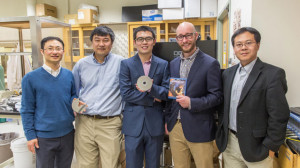
An interdisciplinary team from the McCormick School of Engineering and Applied Science discovered that using the data storage pattern from a Blu-ray disc improves solar cell performance and that video content doesn’t matter.
Credit: Northwestern University
Since its launch, the Blu-ray disc has been promoted as the bigger, better, and more impressive way to view movies at home. But researchers from Northwestern University are now telling us that Blu-ray discs are good for more than just giving us a better home viewing experience.
An interdisciplinary team from the McCormick School of Engineering and Applied Science at Northwestern University has published research stating that Blu-ray discs can be used to improve the performance of solar cells.
These high-density data discs get their hue from microscopic structures etched into their surface, which in turn can make solar panels more efficient by increasing the light absorption of the material they’re on.
In order to make solar cells more efficient, texture can be placed on the cell in order to scatter light more effectively, thus increasing the cell’s efficiency. Because of the Blu-ray disc’s quasi-random pattern, it provides the right texture to improve the cells’ light absorption across the solar spectrum.
The researchers also state that the video content doesn’t matter – whether you have an unwanted copy of “The Wolverine” or are trying to get rid of one of your six copies of “My Cousin Vinnie” – your old Blu-ray discs have the potential to fulfill a “green” second use.
This from Northwestern University:
The Northwestern researchers have demonstrated that a Blu-ray disc’s strings of binary code 0s and 1s, embedded as islands and pits to store video information, give solar cells the near-optimal surface texture to improve their absorption over the broad spectrum of sunlight.
If your research topics of interest include solar energy, you’re not going to want to miss the opportunity to network with the greatest minds in electrochemical and solid state science and our next two meetings: 227th ECS Meeting in Chicago, Illinois, USA & ECS Conference on Electrochemical Energy Conversion & Storage with SOFC-SIV in Glasgow, Scotland.
In the meantime, make sure to keep up with the latest trends in solar energy through the research found in our Digital Library.


